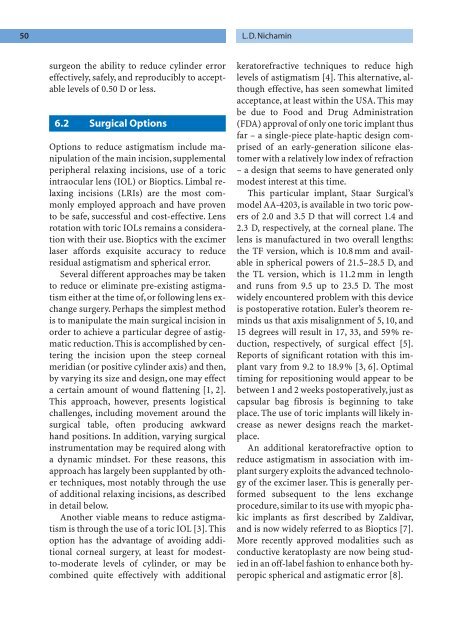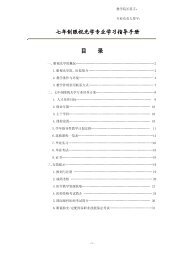Refractive Lens Surgery
Refractive Lens Surgery
Refractive Lens Surgery
Create successful ePaper yourself
Turn your PDF publications into a flip-book with our unique Google optimized e-Paper software.
50 L.D. Nichamin<br />
surgeon the ability to reduce cylinder error<br />
effectively, safely, and reproducibly to acceptable<br />
levels of 0.50 D or less.<br />
6.2 Surgical Options<br />
Options to reduce astigmatism include manipulation<br />
of the main incision, supplemental<br />
peripheral relaxing incisions, use of a toric<br />
intraocular lens (IOL) or Bioptics. Limbal relaxing<br />
incisions (LRIs) are the most commonly<br />
employed approach and have proven<br />
to be safe, successful and cost-effective. <strong>Lens</strong><br />
rotation with toric IOLs remains a consideration<br />
with their use. Bioptics with the excimer<br />
laser affords exquisite accuracy to reduce<br />
residual astigmatism and spherical error.<br />
Several different approaches may be taken<br />
to reduce or eliminate pre-existing astigmatism<br />
either at the time of,or following lens exchange<br />
surgery. Perhaps the simplest method<br />
is to manipulate the main surgical incision in<br />
order to achieve a particular degree of astigmatic<br />
reduction. This is accomplished by centering<br />
the incision upon the steep corneal<br />
meridian (or positive cylinder axis) and then,<br />
by varying its size and design, one may effect<br />
a certain amount of wound flattening [1, 2].<br />
This approach, however, presents logistical<br />
challenges, including movement around the<br />
surgical table, often producing awkward<br />
hand positions. In addition, varying surgical<br />
instrumentation may be required along with<br />
a dynamic mindset. For these reasons, this<br />
approach has largely been supplanted by other<br />
techniques, most notably through the use<br />
of additional relaxing incisions, as described<br />
in detail below.<br />
Another viable means to reduce astigmatism<br />
is through the use of a toric IOL [3]. This<br />
option has the advantage of avoiding additional<br />
corneal surgery, at least for modestto-moderate<br />
levels of cylinder, or may be<br />
combined quite effectively with additional<br />
keratorefractive techniques to reduce high<br />
levels of astigmatism [4]. This alternative, although<br />
effective, has seen somewhat limited<br />
acceptance, at least within the USA. This may<br />
be due to Food and Drug Administration<br />
(FDA) approval of only one toric implant thus<br />
far – a single-piece plate-haptic design comprised<br />
of an early-generation silicone elastomer<br />
with a relatively low index of refraction<br />
– a design that seems to have generated only<br />
modest interest at this time.<br />
This particular implant, Staar Surgical’s<br />
model AA-4203, is available in two toric powers<br />
of 2.0 and 3.5 D that will correct 1.4 and<br />
2.3 D, respectively, at the corneal plane. The<br />
lens is manufactured in two overall lengths:<br />
the TF version, which is 10.8 mm and available<br />
in spherical powers of 21.5–28.5 D, and<br />
the TL version, which is 11.2 mm in length<br />
and runs from 9.5 up to 23.5 D. The most<br />
widely encountered problem with this device<br />
is postoperative rotation. Euler’s theorem reminds<br />
us that axis misalignment of 5, 10, and<br />
15 degrees will result in 17, 33, and 59% reduction,<br />
respectively, of surgical effect [5].<br />
Reports of significant rotation with this implant<br />
vary from 9.2 to 18.9% [3, 6]. Optimal<br />
timing for repositioning would appear to be<br />
between 1 and 2 weeks postoperatively, just as<br />
capsular bag fibrosis is beginning to take<br />
place. The use of toric implants will likely increase<br />
as newer designs reach the marketplace.<br />
An additional keratorefractive option to<br />
reduce astigmatism in association with implant<br />
surgery exploits the advanced technology<br />
of the excimer laser. This is generally performed<br />
subsequent to the lens exchange<br />
procedure, similar to its use with myopic phakic<br />
implants as first described by Zaldivar,<br />
and is now widely referred to as Bioptics [7].<br />
More recently approved modalities such as<br />
conductive keratoplasty are now being studied<br />
in an off-label fashion to enhance both hyperopic<br />
spherical and astigmatic error [8].



